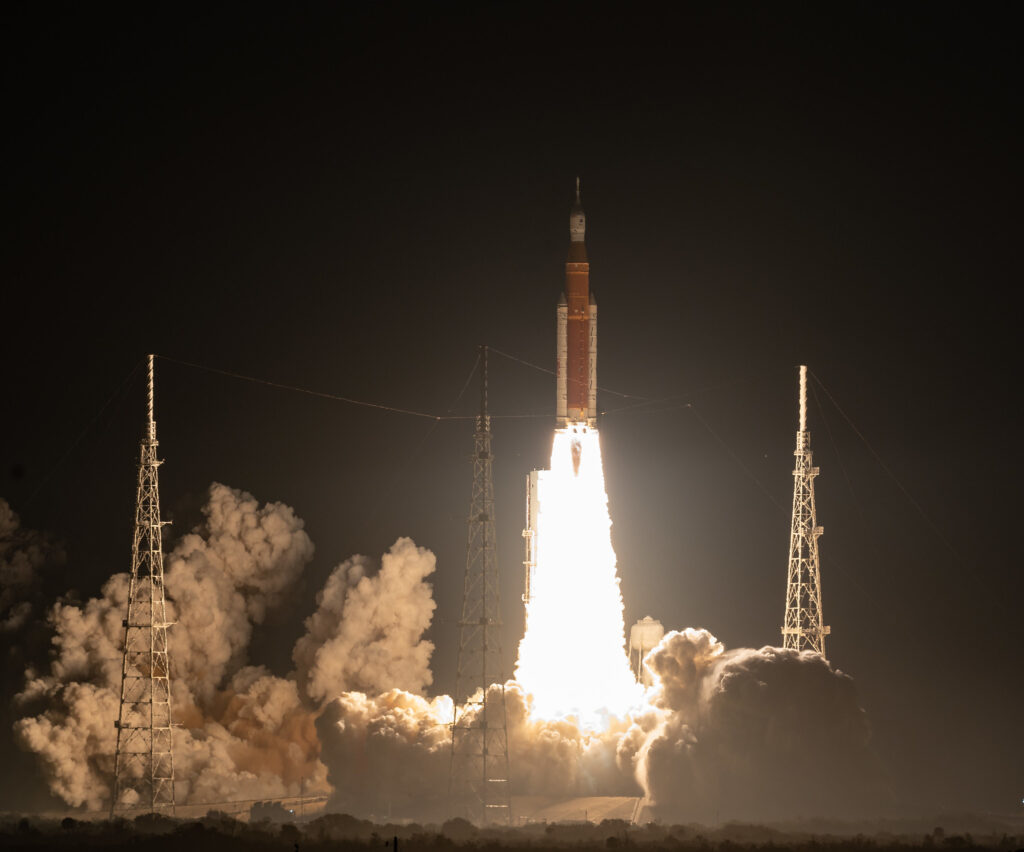
NASA’s Space Launch System rocket carrying the Orion spacecraft launches on the Artemis I flight test, Wednesday, Nov. 16, 2022, from Launch Complex 39B at NASA’s Kennedy Space Center in Florida. Photo: NASA/Bill Ingalls.
The launch of Artemis I might be marked in history as a new beginning of human space exploration.
This was a risky test mission, which took more than a decade of development and over $40 billion in investment. It was the first voyage of the most powerful rocket ever built by NASA, called the Space Launch System (SLS), and the success of the mission meant that soon the Orion spacecraft could take humans to the beginning of a new phase of long-term journeys in space.

In ancient Greek mythology and religion, Artemis is the goddess of the hunt, the wilderness, wild animals, nature, vegetation, childbirth, care of children, and chastity. She was heavily identified with Selene, the Moon, and Hecate, another Moon goddess, and was thus regarded as one of the most prominent lunar deities in mythology. The goddess Diana of Versailles is her Roman equivalent. (Wikipedia ).
The main purpose of the mission was to test Orion’s systems in a spaceflight environment and its safety for delivering humans to the moon and back.
The Orion spacecraft and SLS rocket lifted off from NASA’s Kennedy Space Center in Florida, for a journey of more than a million miles. As of January 27, 2023, the space agency continues to evaluate data from the first flight of the SLS rocket, and is now busy with preparations for future Artemis missions.
The Artemis II is planned to be a crewed lunar flyby. According to the European Space Agency (ESA), Artemis I “is more technical, testing the capabilities of the Orion spacecraft with NASA’s SLS rocket as well as maneuvers and trajectories for flights beyond the Moon. Building on this, the second mission will continue to test the functionality during a crewed mission. As such, Orion will be equipped with oxygen tanks for its second mission, which are not needed for the ground-controlled Artemis I. Other additions in the crew module include crew displays and full life support”.

The Moon is Earth’s only natural satellite. It is the fifth largest satellite in the Solar System and the largest and most massive relative to its parent planet, with a diameter about one-quarter that of Earth (Wikipedia). Photo: Gregory H. Revera.
Some say this is the beginning of a series of spaceflights that could end up with humans colonizing Mars.
For now, the plans go as far as Artemis III, a mission scheduled for 2025, that aims to take the first woman and the first person of color to walk on the moon’s surface. More specifically, the landing will be on the Lunar South Pole – a different region which we have not visited yet, so we can learn more about the origin and evolution of our natural satellite. The plan is to use SpaceX’s human landing system to transport a total of four highly-trained astronauts from the Orion crew capsule in lunar orbit, to the surface of the Moon and back.

Colonization or settlement of Mars is the theoretical human migration and long-term human establishment of Mars. The prospect has garnered interest from public space agencies and private corporations and has been extensively explored in science fiction writing, film, and art (Wikipedia). Image: D Mitriy.
Many in the space industry have questioned the economic objectives of the Artemis program.
For former NASA deputy administrator, Lori Garver, NASA is motivated by ‘the wrong reasons’. According to her, sending more people to the moon would only make sense if the goal was to reduce costs, making space exploration more economically viable – which she does not believe to be the case with the SLS system.
The Artemis program could lead to a new space station in the moon’s orbit, as well as outposts on the lunar surface, where humans could stay for extended periods. But the success of the Artemis could take us even further.
For NASA administrator Bill Nelson, in an August 2022 briefing, this experience on the moon will help us learn and prepare for future Mars missions: “We’re going to Mars, and we’re going back to the moon in order to learn to live, to work, to survive. How do you keep humans alive in those hostile conditions? We’re going to learn how to use the resources on the moon in order to be able to build things in the future as we go”.
NASA’s objective is to build a permanent base on the moon by around 2030.
The space agency, in partnership with the Japan Aerospace Exploration Agency (JAXA), has been testing prototypes like a pressurized lunar rover that would be needed for daily life on Earth’s satellite. The tests are being conducted by NASA’s Desert Research and Technology Studies (Desert RATS), and according to this PBS report, the “current vehicle offers a bumpy ride along the rough terrain, rolling along on six independently rotatable wheels, and has slightly more breathing room than a family van.”
To Dr. Teasel Muir-Harmony, a historian of science and technology and the curator of the Apollo Collection at the National Air and Space Museum, the greatest immediate impact of the Artemis program will be its inspiration for future scientists around the globe.



